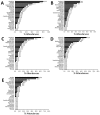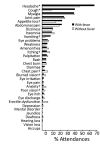Sequelae and Other Conditions in Ebola Virus Disease Survivors, Sierra Leone, 2015
- PMID: 27983503
- PMCID: PMC5176247
- DOI: 10.3201/eid2301.160631
Sequelae and Other Conditions in Ebola Virus Disease Survivors, Sierra Leone, 2015
Abstract
We rapidly assessed the health of Ebola virus disease (EVD) survivors in Kenema, Sierra Leone, by reviewing medical charts of all patients attending the Survivor Clinic of Kenema Government Hospital. Data were abstracted on signs and symptoms at every attendance. As of November 2015, a total of 621 attendances by 115 survivors with laboratory-confirmed EVD were made to the Survivor Clinic. Most (60.9%) survivors were women. Survivors' median age was 28 years (range 0.25-70 years). Survivors attended the clinic a median of 5 times (range 1-21 times) each, and the median time from EVD discharge to attendance was 261 days (range 4-504 days). The most commonly reported signs and symptoms among the 621 attendances were headache (63.1%), fever (61.7%), and myalgia (43.3%). Because health needs of EVD survivors are complex, rapid chart reviews at survivor clinics should be repeated regularly to assess the extent of illness and prioritize service delivery.
Keywords: Ebola virus disease; Sierra Leone; sequelae; survivors; viruses.
Figures





References
-
- World Health Organization. Ebola situation report—9 December 2015. [cited 2015 Dec 14]. http://apps.who.int/ebola/current-situation/ebola-situation-report-9-dec...
MeSH terms
LinkOut - more resources
Full Text Sources
Other Literature Sources
Medical
Research Materials

